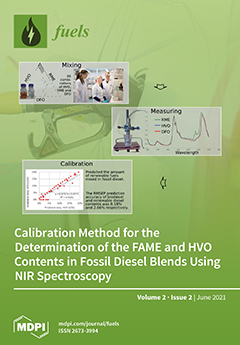Biogas, consisting of CH
4 and CO
2, is a promising energy source and can be converted into H
2 by a dry reforming reaction. In this study, a membrane reactor is adopted to promote the performance of biogas dry reforming. The
[...] Read more.
Biogas, consisting of CH
4 and CO
2, is a promising energy source and can be converted into H
2 by a dry reforming reaction. In this study, a membrane reactor is adopted to promote the performance of biogas dry reforming. The aim of this study is to investigate the effect of pressure of sweep gas on a biogas dry reforming to get H
2. The effect of molar ratio of supplied CH
4:CO
2 and reaction temperature is also investigated. It is observed that the impact of
psweep on concentrations of CH
4 and CO
2 is small irrespective of reaction temperature. The concentrations of H
2 and CO increase with an increase in reaction temperature
t. The concentration of H
2, at the outlet of the reaction chamber, reduces with a decrease in
psweep. It is due to an increase in H
2 extraction from the reaction chamber to the sweep chamber. The highest concentration of H
2 is obtained in the case of the molar ratio of CH
4:CO
2 = 1:1. The concentration of CO is the highest in the case of the molar ratio of CH
4:CO
2 = 1.5:1. The highest sweep effect is obtained at reaction temperature of 500 °C and
psweep of 0.045 MPa.
Full article




